100 Films to Watch If You're Going to Study Film
Part 1
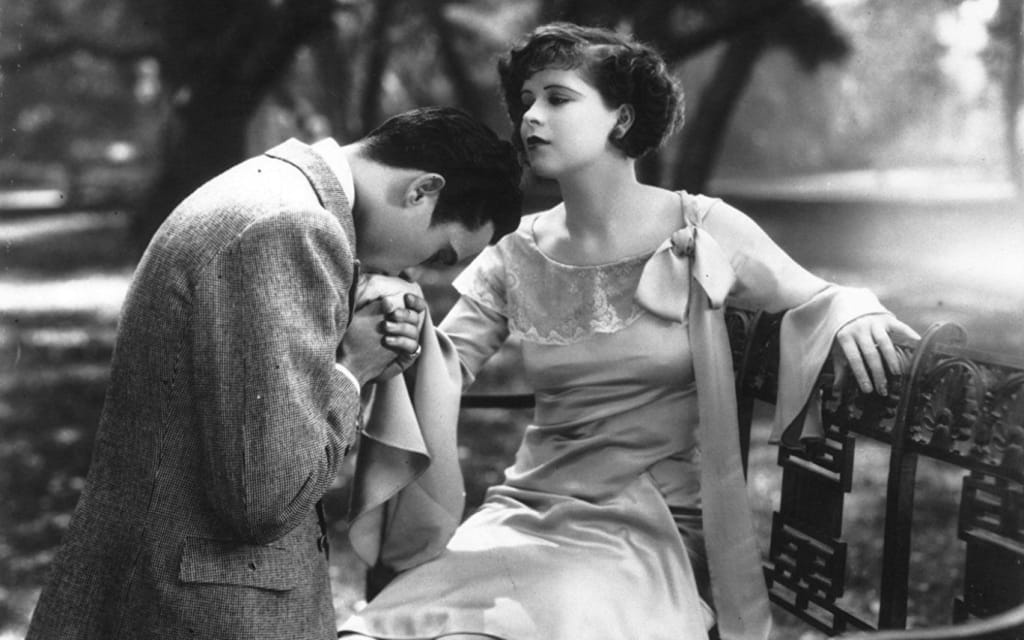
As you all know, I hold a MA in Film and Writing and have a lot of experience with writing and studying film. I love this medium of entertainment because it involves so much storytelling and art in order to convey a productive and interesting narrative.
In my time, I have studied many films and looked into the various international cultures of film including: French, Japanese, Polish, Indian, American, British, Irish, German, Italian and even Spanish. I've loved and loathed many a film and have really studied in-depth what the film is trying to teach us. As you all know, I've written many articles on horror film since it is my speciality and I love sharing my ideas and analysis of the symbolism, theories, allusions and even full-blown meanings conveyed by the film. So far, we have covered films such as:
- The Shining (1980)
- The Conjuring [Universe]
- Get Out (2017)
- The Woman in Black (2013)
And many more. We've also covered ideas in basic screenplay writing, (and it's okay if you want to write a cinematography script with all the camera movements and frames! It's also okay if you don't!), we've covered themes and symbols - how to use them and why we use them. We've analysed various types of scenery used in horror and what certain aspects of sound, space and levels can do to the scene and it's been a lot of fun. So much so, that I'm planning a whole new series of "A Filmmaker's Guide to..."; consider the following season to be season two.
It's been a great first season and I've loved writing these as much as (I hope) you've enjoyed reading them. I want to thank everyone who has read them and got something new and exciting from my articles and, as we move into the second season of them I hope this will continue.
Making your way through this list in any order should assure you a good range of different films in order to start your study. What I suggest is you take in what the "message" of the film is and how this is conveyed in symbolism, dialogue, character placement and movement, directorial style and even cinematography. You need to ask yourself all of these questions that may be more indirect in conveying meaning, even space and levels could do something for it!
These questions will help you gather evidence and answer the question more thoroughly than just using the plot of the film and context of the time it is produced and released in. If need be, even look into the philosophies of the film (concerning people like Fritz Lang, I think you'll be pleasantly surprised!—but I'd be careful with DW Griffith *nervous laughter*).
We're going to end season one of "A Filmmaker's Guide to..." by spending some time looking at the first part of "100 Films to Watch If You Want to Study Film..."—this can be at any level: At school, at college, at film school, at university or even at the height of your academic career (like me. Yes, I'm not a great example but hey!) So excuse me, PhD proposal, but I would like to wind-down for a change!
I'd also like to say that this article is dedicated to a very special friend of mine who would love to be director when she is older. She may be a lot younger than I am, but she knows a hell of a lot about film and analysis for someone of her age. I hope she does well and ends up studying film like she wants to and becoming a great director someday!
(How rude! You never ask a lady's age—I'm 23 at this present moment, you monsters.)
Let's get on with this list and thank you for taking part in season one of "A Filmmaker's Guide to..." (Part 2 will come out very soon!)
Oh, and we're going to go forwards, not backwards this time. A (*) will indicate my personal favourites and there will be notes of mine intermittently.
1-10
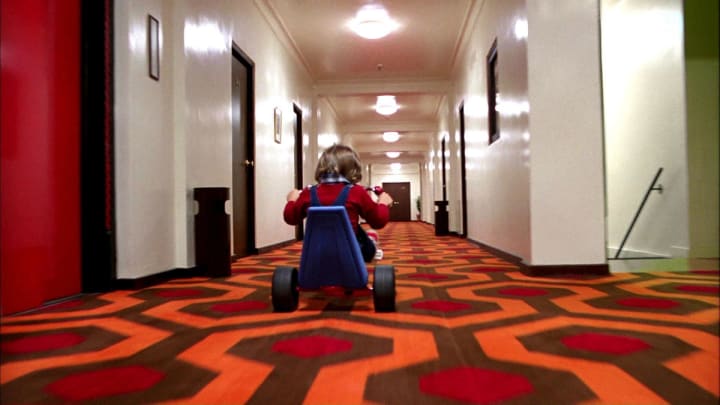
Still from The Shining (1980)
1. The Shining*
As you all know, I wrote an article on The Shining for Halloween and it made a "Staff Pick" (I was very happy)—quite a few people read it and I was pleased with that. I can honestly say I worked my butt off on that article and well, it's a great film so I had too. I won't talk too much about this, but if you look through my writings, you're sure to find the article on The Shining. It goes through the various symbols and stills used to create horror, I think you might like it!
2. The Godfather [Trilogy]*
The quintessential trilogy to watch for any film student. I will say that possibly the first part is the most important, but the second part is the most popular—and if you want to learn how to finish a film with great finesse and excitement, then the third part is for you. For me, the most important scene was always the scene where Don Vito is playing with his grandson in the garden before he dies; it is a massive contrast to the gangster film this is supposed to be. It is a great addition of humanity. Just look at that change in atmosphere!
3. Citizen Kane*
I studied this film for a very long time and have probably watched it over 15 times. I will say this though, this film has been very over-analysed. Give it one or two watches and really try to get into the characterisation that Orson Welles portrays and how it is portrayed. The whole aspect of Xanadu is a characterisation itself and becomes a fascinating theme of reflection of vice.
4. Dr. Strangeloveor: How I Learned to Stop Worrying and Love the Bomb*
This film is an absolute classic. I myself have seen it three times and would definitely watch it again. Kubrick is not only a genius of the screen but, this one is a highly underrated anti-war 60s societal critique. It is a brilliant film to analyse. The anti-war message is so strong through character, mis-en-scene, dialogue ("You can't fight here! This is the war room!" *laughs to self hysterically*) and even the way in which characters are positioned (just look at the guy lying down claiming his leg is hurt; he's on the sofa). Personally, I'd love to see what you make of this film when you come to it.
5. The Cabinet of Dr. Caligari* [Silent Film]
I want to do my PhD on German Expressionism so stop stealing my thunder. No go ahead and steal it. Anyways, this film is a great, great film to analyse as it is considered to be the peak of the German Expressionist period. There are all these straight jagged edges and these shadows produced to represent light and shadow, the tinting for night and day, even the make-up and dress of the characters is representative of the movement towards the Weimar Republic film production. The conveying of context in Germany is strong at this time so have a look at what kind of ideas in the film give away the feel of Germany during the production time of the movie. Personally, I have so much to write on German Expressionism and Weimar Republic film that I think I could explode, so I may make another article explaining myself rather than write it all here.
6. Cloud Atlas*
Okay, so I added this in as a personal favourite. But look at the narrative style in this film (I also recommend you read the book in order to understand it more) and the way in which every single era of time is conveyed through the appearance of the set, the design of the characters and even certain aspects of mis-en-scene. Even the cinematography gets in on the action, becoming smoother and having less splicing in some places. I won't say very much because I want you to watch it and find out for yourself what you think the meaning of this film is.
7. Casablanca
Casablanca is one of the most celebrated films in history, and for good reason. This film has a great cinematography style and seriously, look at those shots! The use of space in this film is something to look out for because it really does represent the strained or close relationships between characters and characters, and also between characters and places. There a various symbols of things dotted throughout in moments of the film that add to the meaning of the overall piece; all in all, it is an excellent one to study. Again, be careful, because a lot has been written on this film already!
8. The Exorcism of Emily Rose*
Okay, so I have another personal favourite on this list. I love looking at the effect of the religious imagery and the use of music in this film. There is a strong use of sound parred with religion in the film since the main theme of the film is the aspect of religion and death. It is this strong, almost choir-based/string-based music that gives rise to atmosphere in the film. The psychological connection between religion and fear is based mostly on this. But if you want more information, you would want to read my article on The Exorcism of Emily Rose.
9. A Clockwork Orange
10. 2001: A Space Odyssey
11-20

Still from Seven
11. Seven
12. Battle Royale*
One of my personal favourite film, this one is Japanese. I love this film for its portrayal of corruption and its critique of the climate of politics throughout the world. It's a brilliant film to watch if you want to learn about political allegories and contains some excellent symbolism through weaponry, false idealism, death and suicide, violence, gender and even protection. But I will say again, since it is a cult film, many have already analysed it so, make sure you read around to avoid repeating anyone else! I would recommend analysing the aspect of morality and ethics and how it's represented through cinematography and "cuts to black." That's quite obscure but always a good idea!
13. Wings [Silent Film]
14. Safety Last [Silent Film]
15. Psycho*
One of the most famous thriller films ever created, this spun of the Bates Motel rubbish we are left with today. Psycho (1960) is a brilliant film for studying film psychology and audience reaction psychology. There is something about the duality represented by light and shadow in this film that does a certain amount of good when foreshadowing the type of ending we are due to come to when we see the famous evil-smile scene penultimately. I want you to think about this question: "How does this film represent the contextual tensions in America during the time of its production and release?"—that's a big one! My article on this film also explains a lot, so if you would like to go through it, it is around there on my page if you flick through.
16. Nosferatu* [Silent Film]
The 1922 version please. This film is great for studying the rise and peak of German Expressionism. Like Caligari, this film has a certain way of portraying horror without explicitly stating anything—it is more naturalistic than most films during the silent era. There are many great scenes and frames to analyse throughout the film and there are many questions to ask about its portrayal of monsters. Unfortunately, this is another one that has been mostly analysed, and so I would like you to try and think about an answer to the following question: "How does this film portray the masculinity of monsters?" I have also done my own analysis on the horror filmmaking in this movie so, if you would like to know more then have a flick through my page to find out!
17. The Gold Rush [Silent Film]
18. Metropolis [Silent Film]
19. Fight Club
20. Ed Wood*
This film, again, is one of my personal favourites. It is an excellent example of grand cinematography and extreme irony. This film was actually more famous than the man it is about and I find that incredibly funny in terms of the fact, that is exactly the extended metaphor in the film. I would like you to concentrate on the aspect and usage of black and white to convey irony in this film and how cinematography contributes to this. It is these physical aspects that really put it out there and that, at the end of the day, is what makes it funny and famous.
21-30
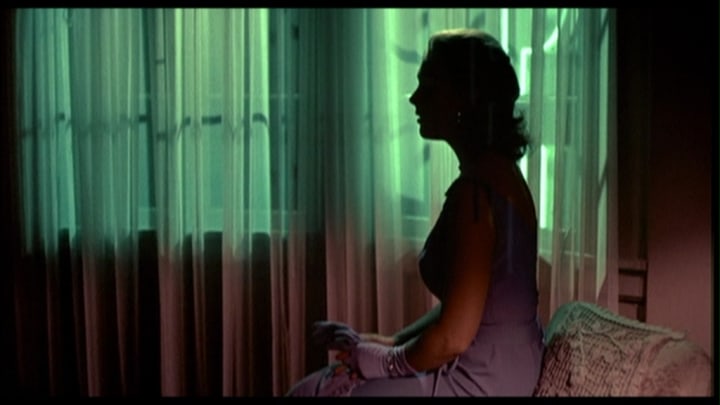
Still from Vertigo
21. Vertigo*
All I'm going to say about this is that it's my favourite Hitchcock film because of its presentation of duality through foreshadowing, light and shadow. The colours of this film are amazing and the representation of character through mis-en-scene, space, levels, and cinematography are of classic Hitchcockian style. I would love for you to watch this film and ask questions about characterisation and foreshadowing because there are so many questions to ask.
22. Pulp Fiction
23. The Jazz Singer* [First "Talkie"]
Yes, it has a lot of cultural importance as being the first real "talkie" film. It also has a great cultural message and is very important for the outbreak of music and film being intertwined together. I love this film and have seen it many, many times now—this is because of the way it shifts the style and narrative perspectives throughout. The narrative style through cutting, editing, and cinematography portrays the story brilliantly. It is a beautiful film and I'd love for you to watch it.
24. A Streetcar Named Desire
25. Rebecca
26. It Happened One Night
27. Full Metal Jacket
28. Apocalypse Now
29. Blade Runner
30. The Ring [Japanese Version]
31-40
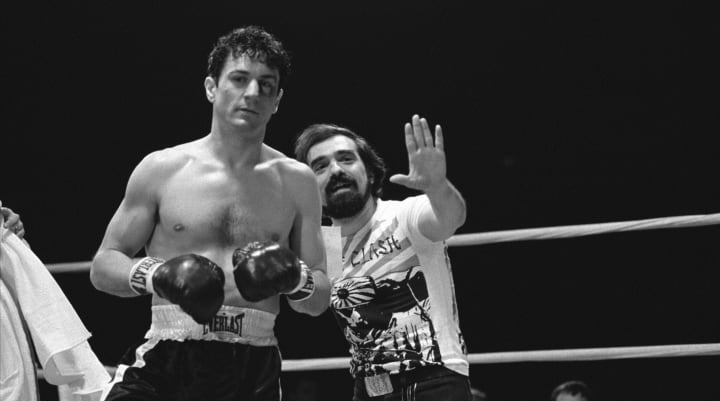
Still from Raging Bull
31. Raging Bull
32. Schindler's List*
Some of the shots in this film are an act of pure perfection. I want you to really look at the use of space, colour, light, and shadow in this film and how it is meant to present atmosphere and represent a certain context. There is so much powerful meaning behind this film that it went on the win Best Picture at the Academy Awards. The film's use of context is strong in character and description, dialogue and character design, but have a look at the technical side as well. You may be pleasantly surprised.
33. The Shawshank Redemption
34. Jaws
35. Jackie Brown
36. Top Hat
37. Goodfellas
38. Lawrence of Arabia
39. One Flew Over the Cuckoo's Nest
40. Thelma and Louise
41-50

41. Singin' in the Rain
42. Chinatown
43. Rear Window
44. Forrest Gump
45. True Romance
46. Some Like It Hot
47. City Lights
48. E.T.
49. Gone with the Wind
50. Eyes Wide Shut*
One of the most enigmatic of Kubrick's films, made only a short while before he died—this film is an excellent example of what happens when mystery/thriller meets high drama. It is a mixture between horror, romance, and crime with an amazing colour palette. I think the use of colour and space in this film are the product's two most important aspects. I would recommend you try to study questions around the use of colour and what it means in the movie for certain characters. The characters and the use of colour intertwine beautifully in this film and I think you'll like what you find out!
51-60

Still from The Third Man
51. The Third Man
52. Taxi Driver
53. The Exorcist*
I have constantly spoken about how much I adore this film; I am absolutely in love with it and would watch it over and over again. If you're interested, you should read my article on my page about The Exorcist and how it adds to the way horror films are made. It was a seminal film and the amount of times I've seen it, well, I'd be worried about me. This is an excellent film and there are many aspects to analyse. But really, if you'd like more information then please either read the article I published phrased "The Filmmaker's Guide to The Exorcist"—or don't hesitate to contact me @3ftMonster on Twitter. I'd love to have a discussion about this film if you're willing.
54. The Apartment
55. The Birds*
This film has some excellent shots. Especially the build of tension through tracking shots on character and then, BAM! a shock value shot. It is classic Hitchcock once again and you really need to appreciate the amount of work on cinematography that has gone into this film. Please watch it at least once and think about this question: "How does the cinematography of the film add to the suspense created by the build of tension in the plot?" Difficult, I know, but in all aspects it is a beautiful film.
56. Barry Lyndon*
57. Don't Look Back*
58. Battleship Potemkin
59. The Rocky Horror Picture Show*
60. Inglorious Basterds*
61-70

Still from The Silence of the Lambs
61. The Silence of the Lambs*
One of my personal favourites to watch to study cinematography to represent character. Notice the smooth shots we have as we close in on Hannibal Lecter in the shot shown above. It is a brilliant thing and no, I don't believe it is a tracking shot since Clarice walks into frame and the camera isn't exactly tracking her. The most beautiful thing about this film though is its use of light and shadow to create atmosphere. The style of this film is hardcore modern gothic and it has some dark scenes to foreshadow and lighter ones to create shock.
62. Strangers on a Train
63. Bram Stoker's Dracula
64. My Left Foot*
65. Patton
66. The Texas Chainsaw Massacre*
Please watch the very first one from the 1970s. This film is an excellent one to study for violent horror. To study the atmosphere through the style of cinematography and use of colour, this would be the perfect film. You could ask yourself the question: "How does the use of colour emphasise differences between the group of characters on the outside of the house and the group of characters inside the house?" This is tricky, but it is a really fun question to answer.
67. Lolita
68. The Rainmakers
69. Don Juan DeMarco
70. 12 Angry Men*
71-80

Still from Man with a Movie Camera
71. Man with a Movie Camera
72. There Will Be Blood*
73. 28 Days Later
74. Interview with the Vampire*
75. Good Will Hunting
76. Dial M for Murder*
77. This Is Spinal Tap
78. West Side Story
79. Spartacus
80. Die Hard
81-90
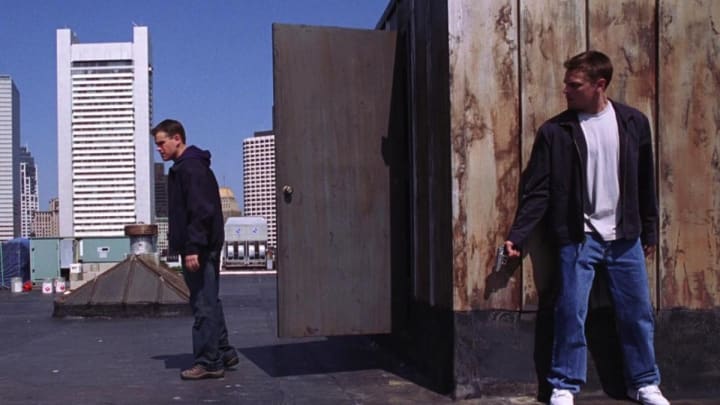
Still from The Departed
81. The Departed
82. Gangs of New York*
83. The Passion of the Christ*
84. Eternal Sunshine of the Spotless Mind
85. The Unbearable Lightness of Being
86. The Man Who Knew Too Much
87. Lincoln*
88. Breakfast at Tiffany's
89. American Psycho*
One of the seminal movies of the early 21st Century, this film mixes contextual irony with dark comedy with real-world horrors that are totally possible. The best thing about this film is the great cinematography and how it presents character. The narrative of Patrick Bateman is directed through the shots and how the shots are edited together. The various POV-close-ups throughout the film that we see when Bateman is concentrating on something (i.e. the business card scene) is brilliant. I would love it if you analysed how cinematography conveys character. It's so much fun to analyse.
90. Paths to Glory
91-100

91. Brokeback Mountain
92. Amadeus
93. The Elephant Man
94. Malcolm X
95. The Prestige*
This film is so many levels of characterisation and cinematography. It is a filmmaker's dream to analyse this film. I love the way that this film is edited to convey a certain message and that message is: You only see what the filmmaker wants you to see. The misdirection of this film is incredible and I would recommend watching it at least three times to really get the flavour of this message. After that, I would like you to have a go at answering the question: "How does the editing misdirect the audience attention to the film?" It is a brilliant question and really does give you a lot to work with.
96. To Catch a Thief
97. The Last of the Mohicans
98. The Fighter
99. I'm Not There*
100. Jurassic Park*
Conclusion
I hope you've enjoyed this article and learnt a lot from it as well as got some ideas on what to analyse for your next project. There is a lot to analyse in film and I really wish I could've gone through every film on the list but we will be here all day. The thing is, you really have to analyse the entirety of the film, concentrating on the aspects that are most representative of the message in the film. There is also an amount of obscure aspects you could analyse, which is probably better for the more popular films.
Again, I hope you've enjoyed this article. I've had so much fun writing for you and giving you all this cool information that's resting in my head. There's so much to be learnt from film and, with season one done, we are only at the beginning!
About the Creator
Annie Kapur
200K+ Reads on Vocal.
English Lecturer
🎓Literature & Writing (B.A)
🎓Film & Writing (M.A)
🎓Secondary English Education (PgDipEd) (QTS)
📍Birmingham, UK






Comments
There are no comments for this story
Be the first to respond and start the conversation.